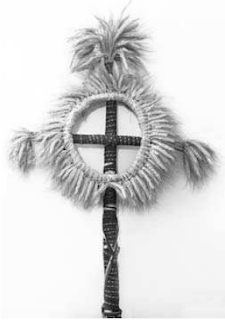As late as the mid 20th century, there was a custom in Poland to bake small loaves of bread for the dead on the All Souls day. Because the All Souls day is in Polish known as Dzien Zaduszki (the day for the souls), the bread was also called zaduszki, bread (for) souls...
Originally these were just a plain sourdough flatbreads...But the recipe gradually evolved into this:
Lublin All Souls' Day breads (powałki)
1 kg of cooked flour potatoes
2 eggs
400 g of wheat flour
100g of fresh yeast
1 teaspoon of sugar
2 flat teaspoons of salt
Press the previously cooked and cooled potatoes through a press, add eggs, flour, salt and yeast grated with sugar. Knead the mixture into a loose dough. Tear off pieces of dough, form thick flat patties and place them on oiled baking tray.
Decorate each patty with a grid pattern using a fork, and leave them to rise for 30 minutes. Bake for 20-30 minutes in an oven preheated to 160°C.
That's the traditional recipe. If you want, you can add cheese, ham, spices or any other topping of filling to suit your taste...
The origin of this ritual in the old Slavic feast called Dziady, which in Polish means Grandfathers, Forefathers, when the souls of Forefathers would come back to our world to visit their descendants. And the little (soul) breads were made as food for the visiting ancestors.
The soul breads had to be prepared a few days in advance, as people did not want to light the fire on the hearth on All Saints' Day, as they believed that the visiting souls gathered around the house hearth, and they didn't want to disturb them...
Two interesting things here.
First: Slavs believed that it was the (happy) ancestors (satisfied with the way their descendants treated them) who were the source of all good that their descendants enjoyed. Including (and especially) good grain harvest...I talked about this in my post "Diduch" (grandfather), about the East Slavic symbolic representation of the ancestral spirit which governs the lives of the living.
So a bread for the dead now makes a lot of sense, right? I talked about the ancestral cult root of Slavic agricultural rituals in many of my blog posts and twitter threads. This post, "Wheat cross", is a good jumping point for exploring this subject further. It talks about the ceremonial "wheat cross" from Romania, which was made on the last day of the wheat harvest to carry the "wheat wreath" from the fields to the village. And about the related Slavic harvest traditions and ritual.
Second: Hearth as the place where the dead gather when they visit the house of their descendants. I talked about the link between the dead and the hearth in my post about "Verige" (hearth chain).
As you can see from the above picture, in the past, the hearth was the focal point of every house. So it is easy to imagine that the souls of the dead ancestors would also gather around the hearth to warm themselves up on the cold November night...
This is confirmed by the fact that in the past in Poland, on All Souls eve, people used to set up bonfires on the crossroads, in order to help the souls of the ancestors warm up a bit...Why on crossroads? Allegedly to show wandering souls their way home...
But interestingly:
In some parts of Serbia, on Christmas eve, a single man from a village would go to a crossroads and lay down a feast for wolves. He would then run home without turning...I talked about this in my post "Wolf feast", about the link between wolves and the ancestors in Serbian folklore.
And also:
Diduch (Grandfather), the grain effigy representing "The Ancestor" made in Ukraine for Christmas, was in some areas, burned on New Year's eve, on crossroads, "one of the favorite hangouts of evil spirits and vampires"...
See how the souls of the ancestors ended up becoming evil spirits and vampires...With a little help of Christian priests...
Finally, some Serbian ethnographers proposed that the belief that the dead gather around the house hearth might also be a remnant of the ancient (really really ancient) practice of burying the dead under and around the hearth...
I am very important!
Love this little guy 🙂 Neolithic Vinča culture anthropomorphic terracotta figurine, 5000 BC, Serbia.
"These figurines were found in houses, often near fireplace, sometimes carefully arranged, which indicates that they had ritual, cult value".
Did they represent the deceased, the ancestors?







I'm a fan of this blog and I'm impressed with how deep your research is. I am polish, I was born in Lublin and I didn't even know about the tradition of powałki baking :) I'd like to correct two small details. Zaduszki isn't the day of All Souls. All souls is 1st of November and Zaduszki is 2nd. Secondly, you either say Zaduszki (a noun) or Dzień Zaduszny ("day" + an adjective). Anyway, thank you for all the work you do here. I'd love to see more posts about Slavic traditions, especially from eastern Roztocze region where my maternal family is from. I wish you all the best and I look forward for more posts :)
ReplyDeleteThank you very much for your comment
Delete